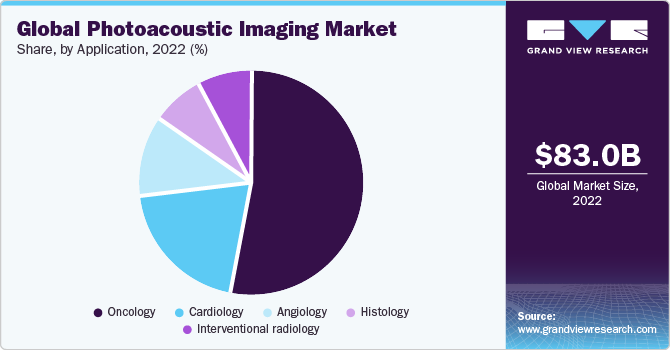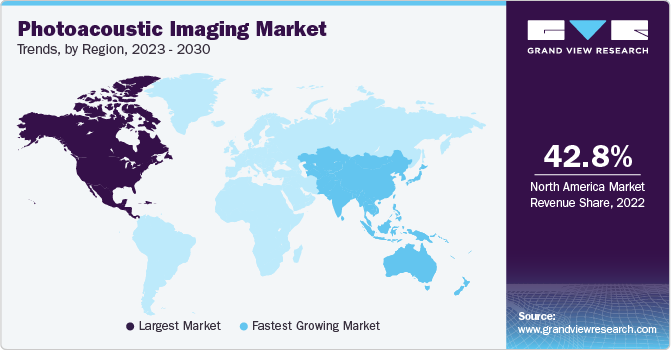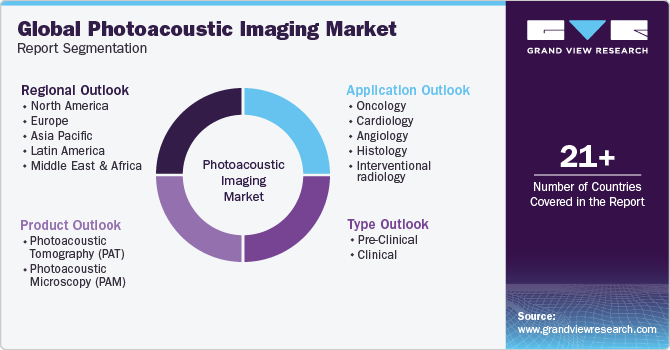- Home
- »
- Medical Imaging
- »
-
Photoacoustic Imaging Market Size & Share Report, 2030GVR Report cover
![Photoacoustic Imaging Market Size, Share & Trends Report]()
Photoacoustic Imaging Market Size, Share & Trends Analysis Report By Product (Photoacoustic Tomography (PAT), Photoacoustic Microscopy (PAM)), By Type (Pre-clinical, Clinical), By Application, By Region, And Segment Forecasts, 2023 - 2030
- Report ID: GVR-4-68039-804-2
- Number of Report Pages: 120
- Format: PDF, Horizon Databook
- Historical Range: 2018 - 2021
- Forecast Period: 2023 - 2030
- Industry: Healthcare
Photoacoustic Imaging Market Size & Trends
The global photoacoustic imaging market size was estimated at USD 83.04 million in 2022 and is projected to grow at a compound annual growth rate (CAGR) of 19.27% from 2023 to 2030. The growth of the market is driven by several factors, such as the increasing incidence of cancer, primarily breast cancer, and rising research studies in non-ionizing radiation for imaging. For instance, as per the report of cancer.net, published in February 2023, about 297,790 women in the U.S. were diagnosed with invasive breast cancer, and 55,720 women will be diagnosed with non-invasive breast cancer in 2023. In addition, the growing scope of applications is equally contributing to the market expansion. Photoacoustic Imaging (PAI) is superior to other diagnostic imaging systems as it uses non-ionizing radiation to examine tissues in real-time with high resolution and contrast at long penetration depths, allowing morphological, functional, and molecular imaging of living subjects.

Technological innovations such as research and development in photoacoustic imaging systems aim at enhancing its resolution, sensitivity, and clinical utility, which are anticipated to boost product demand over the forecast period. The advantages of optical and ultrasonic imaging are combined in near-infrared photoacoustic imaging (NIR-PAI), which delivers high-resolution anatomical and functional information about tissues. PAI offers a unique combination of structural and functional information, making it valuable for early disease detection and monitoring.
The growing application in research and development activities is expected to increase product demand over the forecast period. Recently, many researchers have focused on researching deep tissues to use PAI for clinical diagnosis and treatment. For instance, a new contrast agent for deep tissue PAI was introduced by Prof. Chulhong Kim of Creative IT Engineering at POSTECH and his students. They employed a nickel-based nanoparticle that absorbs light at a wavelength of 1,064 nm as a contrast agent. In contrast to earlier research, scientists could capture photos of live animal tissues pierced to a maximum depth of 3.4 cm. This is the deepest image ever captured utilizing this wavelength.
PAI has faster imaging speed and sensitivity, better handling, and diagnostic accuracy. One of the major advantages of PAI is that it can be simply implemented on clinical ultrasound machines, allowing cellular and molecular imaging to be added to the spectrum of traditional ultrasound imaging. However, constraints, such as the high cost of these systems, limited bandwidth causing an inability to detect signals outside of the sensor's frequency range, acquisition time, and the limitations set by ANSI laser safety regulations, may hinder the market growth over the projected period.
Product Insights
Based on product, the market was dominated by the photoacoustic tomography (PAT) segment in 2022 with a revenue share of 63.22%. Over the forecast period, the segment is expected to continue its dominance and is anticipated to witness the fastest CAGR of 19.62% during the forecast period. PAT is the most adaptable and open-ended photoacoustic imaging method since it has the fewest real-world limitations on picture performance. PAT technology has improved quickly in terms of spatial resolution, frame rates, and detection sensitivity. PAT has had several potential clinical uses, and its use in primary biological sciences has substantially increased. Due to its unique combination of optical absorption contrast and scalable depth and resolution ultrasound imaging, PAT is also projected to have more useful applications in biological research and clinical practice.
The photoacoustic microscopy (PAM) segment is also expected to exhibit a noteworthy CAGR during the forecast period. PAM provides anatomical, functional, and molecular information and has become a more common biomedical technique. Unlike pure optical microscopic methods, PAM uses tissue’s weak acoustic scattering to overcome the optical diffusion limit. PAM’s scalability allows it to produce high-resolution images at specified maximum imaging depths of a few millimeters. Even though PAM has been commercialized for preclinical applications, the future commercialization of clinical applications will significantly accelerate PAM’s translation from laboratory technology to mainstream imaging modality.
Application Insights
In terms of application, the oncology segment dominated the market in 2022 with the largest revenue share of 52.68%, and it is expected to continue its dominance over the forecast period by growing at a CAGR of 20.07%. In oncology, breast cancer imaging is a potentially significant clinical application for PAI. Breast imaging is the most advanced PAI technique in terms of clinical use, with benefits such as non-contrast imaging of the neo-vasculature around a tumor and oxygen saturation mapping.

PAI, as compared to X-ray imaging, can detect tumors in radiologically dense breasts without causing painful breast compression. For instance, The National Institute of Technology (NIT) of Andhra Pradesh (NIT-AP) and Pennsylvania State University (PSU) in the United States announced their collaboration to develop an Artificial Intelligence(AI)-augmented PAI technique for cancer diagnostics. This technique has gained popularity in recent years by allowing precise and early-stage identification of cancer, neurological problems, and vascular disorders.
The cardiology segment held the second position owing to an increased burden on cardiovascular disorders globally. For effective management and treatment of CVDs, accurate diagnosis and real-time interventional guidance are essential. PA imaging is a promising novel imaging technology with therapeutic applications in cardiology since it is intrinsically bonded to and complementary to ultrasound imaging. Furthermore, deep learning (DL) techniques have become more popular as GPU capacity increases. According to the American Heart Association, around 928,741 deaths were accounted to CVD in the U.S. in 2020.
Type Insights
Based on type, the pre-clinical segment held the largest revenue share of around 79.57% in 2022. PAI is an efficient, non-invasive, non-ionizing tool used in pre-clinical studies to characterize small animals, such as mice or rats, without harming them. Characterization of small-animal models of brain damage and disease processes, especially those requiring the study of vascular anatomy and function, such as stroke, epilepsy, and traumatic brain injury, is possible. The widespread use of PAI in the research platform to investigate human disease processes and develop new therapies is expected to promote the growth of the market.
The clinical segment is anticipated to witness the fastest CAGR of around 20.59% over the forecast period due to the growing scope of applications in clinical studies. The PAI modality can be used in diagnostic imaging using endogenous contrast between different tissues; also, it is well-suited for visualizing foreign objects, such as stent needles, as metals or composite materials have a high absorption coefficient. The rate of advancement toward clinical application in oncology, dermatology, cardiovascular medicine, and other specialties is anticipated to accelerate the market growth.
Regional Insights
North America dominated the market with the largest revenue share of 42.81% in 2022. Over the forecast period, the region is expected to grow significantly. The existence of several market competitors in the region and the increasing number of cancer cases seem to be factors contributing to regional market growth. For instance, as per the National Cancer Institute, an estimated 1,958,310 new cancer cases in the United States will be diagnosed in 2023. In addition, improved funding has boosted the region’s research activities. The United States spends the most per capita on healthcare and has the largest funds and grants available for research through government agencies, such as the National Institutes of Health (NIH).

In the Asia Pacific, the market for PAI is estimated to witness the fastest CAGR of around 20.22% during the forecast period, owing to the increased demand for better imaging devices and the rising frequency of research activities. For instance, In September 2021, a group of researchers from South Korea’s Pohang University of Science and Technology (POSTECH) developed a handheld photoacoustic detector that can be used to assess lymph node status without exposing patients to radiation.
Key Companies & Market Share Insights
The key players are improving their offerings by upgrading their products, leveraging important cooperative drives, and considering acquisitions and government approvals to increase their client base and gain a larger global industry share. For instance, in August 2023, TomoWave launched LOIS-3D three-dimensional quantitative optoacoustic tomography (qOAT). Using the most attractive aspects of light and sound, this innovative technology creates three-dimensional visualizations of tiny animal models of human diseases with unsurpassed detail and contrast. Some prominent players in the global photoacoustic imaging market include:
-
Advantest Corp.
-
TomoWave
-
Kibero GmbH
-
FUJIFILM VisualSonics Inc.
-
Seno Medical Instruments
-
iThera Medical GmbH
-
Aspectus GmbH
-
Vibronix Inc.
Photoacoustic Imaging Market Report Scope
Report Attribute
Details
Market size value in 2023
USD 98.76 million
Revenue forecast in 2030
USD 339.02 million
Growth rate
CAGR of 19.27% from 2023 to 2030
Base year for estimation
2022
Historical data
2018 - 2021
Forecast period
2023 - 2030
Quantitative units
Revenue in USD million/billion and CAGR from 2023 to 2030
Report coverage
Revenue forecast, company ranking, competitive landscape, growth factors, and trends
Segments covered
Product, application, type, region
Regional scope
North America; Europe; Asia Pacific; Latin America; MEA
Country scope
U.S.; Canada; UK; Germany; France; Italy; Spain; Norway; Sweden; Denmark; Japan; China; India; Australia; Thailand; South Korea; Brazil; Mexico; Colombia; Argentina; South Africa; Saudi Arabia; UAE; Kuwait
Key companies profiled
Advantest Corp.; TomoWave; Kibero GmbH; Fujifilm VisualSonics Inc.; Seno Medical Instruments; iThera Medical GmbH; Aspectus GmbH; Vibronix Inc.
Customization scope
Free report customization (equivalent up to 8 analysts working days) with purchase. Addition or alteration to country, regional, and segment scope
Pricing and purchase options
Avail customized purchase options to meet your exact research needs. Explore purchase options
Global Photoacoustic Imaging Market Report Segmentation
This report forecasts revenue growth at global, regional, and country levels and analyzes the latest industry trends in each sub-segment from 2018 to 2030. For this study, Grand View Research has segmented the global photoacoustic imaging market report based on product, type, application, and region:

-
Product Outlook (Revenue, USD Million, 2018 - 2030)
-
Photoacoustic Tomography (PAT)
-
Photoacoustic Microscopy (PAM)
-
-
Type Outlook (Revenue, USD Million, 2018 - 2030)
-
Pre-Clinical
-
Clinical
-
-
Application Outlook (Revenue, USD Million, 2018 - 2030)
-
Oncology
-
Cardiology
-
Angiology
-
Histology
-
Interventional radiology
-
-
Regional Outlook (Revenue, USD Million, 2018 - 2030)
-
North America
-
U.S.
-
Canada
-
-
Europe
-
Germany
-
UK
-
France
-
Italy
-
Spain
-
Norway
-
Denmark
-
Sweden
-
-
Asia Pacific
-
Japan
-
China
-
India
-
Australia
-
South Korea
-
Thailand
-
-
Latin America
-
Brazil
-
Mexico
-
Argentina
-
Colombia
-
-
Middle East and Africa (MEA)
-
South Africa
-
Saudi Arabia
-
UAE
-
Kuwait
-
-
Frequently Asked Questions About This Report
b. The global photoacoustic imaging market size was estimated at USD 83.04 million in 2022 and is expected to reach USD 98.76 million in 2023.
b. The global photoacoustic imaging market is expected to grow at a compound annual growth rate of 19.27% from 2023 to 2030 to reach USD 339.02 million by 2030.
b. North America dominated the photoacoustic imaging market with a share of 42.8% in 2022. This is attributable to the rising existence of a large number of market competitors in the region, as well as the increasing number of cancer cases.
b. Some key players operating in the photoacoustic imaging market include Advantest Corporation ; TomoWave; Kibero GmbH; FUJIFILM VisualSonics Inc., Seno Medical Instruments; iThera Medical GmbH; Aspectus GmbH; and Vibronix Inc.
b. Key factors that are driving the photoacoustic imaging market growth include the increasing incidence of cancer, a rise in research studies in the field of non-ionizing radiation, and a wide range of applications.
Share this report with your colleague or friend.
![gvr icn]()
NEED A CUSTOM REPORT?
We can customize every report - free of charge - including purchasing stand-alone sections or country-level reports, as well as offer affordable discounts for start-ups & universities. Contact us now
![Certified Icon]()
We are GDPR and CCPA compliant! Your transaction & personal information is safe and secure. For more details, please read our privacy policy.
We are committed towards customer satisfaction, and quality service.
"The quality of research they have done for us has been excellent."





